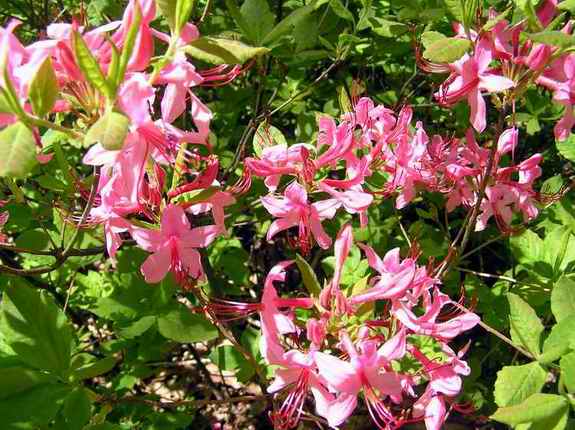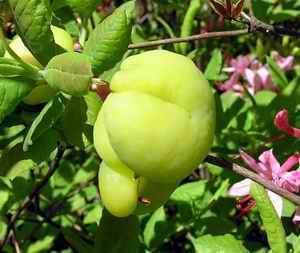|
Return to Hiker's Notebook Home Page
Common Name: Pinxter Flower, Pink Azalea, Wild Azalea, Pink Honeysuckle, Pinxter Bloom, Pinkster Flower- The name Pinxter is the Dutch word for Pentecost or Whitsuntide.
Scientific Name: Rhododendron periclymenoides- The generic name is from the Greek word for rose, rhodon, and dendron, meaning tree; the genus is comprised primarily of shrubs with roseate blossoms. The original species name was nudiflorum which means naked flower; this refers to the early spring efflorescence so that the flowers appear before the leaves are fully advanced and thus adorn denuded branches.
The appellation Pinxter Flower is not intended to indicate that the flowers are pink, though the spelling Pinkster is probably due to this misapprehension. The term is of Dutch origin as a shortened form of Pinxter blomachee which translates roughly as blossoming on the Pentecost. The religious protestant Dutch settlers of the Hudson River Valley noted that the flower reached full bloom near the date of this very important Christian Church festival. Pentecost is a calque of the Greek pentekoste which means fifty days. The New Testament Book Acts begins the second chapter with "When the time for Pentecost was fulfilled, they were all in one place together and suddenly there came from the sky a noise like a strong driving wind". Accordingly, Pentecost is celebrated on the seventh Sunday after Easter and signifies the beginning of Christianity in the sense that the Holy Spirit first appeared to the apostles after the resurrection. It follows that "And they were filled with the Holy Spirit and began to speak in different tongues," which is the etiology of the practice of talking in tongues. Pentecost is also called Whitsunday as an abbreviation for White Sunday, as many people chose to be baptized on this day in the traditional purity of white robes. Whitsuntide refers to the week following Whitsunday. Azalea is an alternative common name for a substantive
subgroup of the genus Rhododendron. Azalea is derived from
azaleos which means dry in Greek, reference to the strong preference that
azaleas have for dry soil habitats, typically the soils made acidic by the
pines of the hills and mountains. Another distinguishing feature is that North
American azaleas are deciduous whereas rhododendrons are evergreen. Because of
the proliferation of cultivars of the genus Rhododendron, subgenera are
often used commercially to distinguish them; Pentathura for azaleas
natives to North America and Tsutsusi for azaleas native to East
Asia. There are several species of azaleas that are very similar in appearance and often mistaken for the Pinxter Flower. They also have a number of different common names, according to the source. R. canescens, commonly known as the Florida Pinxter-flower or Piedmont Azalea, can be distinguished by habitat; it is primarily found in moister areas. R. roseum, Early, Woolly, or Mountain Azalea is more fragrant than R. nudiflorum and has leaves that are hairy on the bottom. The flowers of all species are similar, ranging in color from white to pink and having five long stamens and one very long pistil, a design that fosters pollination by large winged, long-legged butterflies.
|


 Pink
and Mountain Azaleas are subject to galls; irregular, glabrous growths that
can be caused by fungi, bacteria, mites, nematodes and insects, notably gall
wasps such as those that form
Pink
and Mountain Azaleas are subject to galls; irregular, glabrous growths that
can be caused by fungi, bacteria, mites, nematodes and insects, notably gall
wasps such as those that form